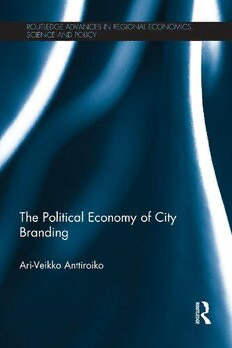
The Political Economy of City Branding PDF
Preview The Political Economy of City Branding
The Political Economy of City Branding Globalizationaffectsurbancommunitiesinmanyways.Oneofitsmanifestations is increased intercity competition, which compels cities to increase their attrac- tiveness in terms of capital, entrepreneurship, information, expertise and consumption. This competition takes place in an asymmetric field, with cities tryingtofindthebestpossiblewaysofusingtheirnaturalandcreatedassets,the latterincludinganaturallyevolvingreputationorconsciouslydevelopedcompet- itiveidentityorbrand. ThePoliticalEconomyofCityBrandingdiscussesthisphenomenonfromthe perspective of numerous post-industrial cities in North America, Europe, East Asia andAustralasia. Special attention is given to local economic development policy and industrial profiling, and global city rankings are used to provide empirical evidence for cities’ characteristics and positions in the global urban hierarchy.Ontopofthis,socialandurbanchallengessuchascreativeclassstrug- glearealsodiscussed. Thecoremessageofthebookisthatcitiesshouldapplythetoolsofcitybrand- ingintheirindustrialpromotionandspecialization,butatthesametimetakeinto accountthespecialnatureoftheirurbancommunitiesandbeopenandinclusive intheirbrandpoliciesinordertoensureoptimalresults. Thisbookwillbeofinteresttoscholarsandpractitionersworkingintheareasof localeconomicdevelopment,urbanplanning,publicmanagementandbranding. Ari-VeikkoAnttiroikoisAdjunctProfessorintheSchoolofManagementatthe University of Tampere, Finland. His research areas include local governance, global intercity competition, e-government, public sector innovations and high- techcentreresearch. RoutledgeAdvances in Regional Economics, Science and Policy 1. TerritorialPatternsofInnovation AninquiryontheknowledgeeconomyinEuropeanregions EditedbyRobertaCapelloandCamillaLenzi 2. ThePoliticalEconomyofCityBranding Ari-VeikkoAnttiroiko The Political Economy of City Branding Ari-Veikko Anttiroiko Firstpublished2014 byRoutledge 2ParkSquare,MiltonPark,Abingdon,OxonOX144RN andbyRoutledge 711ThirdAvenue,NewYork,NY10017 RoutledgeisanimprintoftheTaylor&FrancisGroup,aninformabusiness ©2014Ari-VeikkoAnttiroiko TherightofAri-VeikkoAnttiroikotobeidentifiedasauthorofthisworkhas beenassertedbyhiminaccordancewiththeCopyright,DesignsandPatent Act1988. Allrightsreserved.Nopartofthisbookmaybereprintedorreproducedor utilisedinanyformorbyanyelectronic,mechanical,orothermeans,now knownorhereafterinvented,includingphotocopyingandrecording,orinany informationstorageorretrievalsystem,withoutpermissioninwritingfrom thepublishers. Trademarknotice:Productorcorporatenamesmaybetrademarksor registeredtrademarks,andareusedonlyforidentificationandexplanation withoutintenttoinfringe. BritishLibraryCataloguinginPublicationData AcataloguerecordforthisbookisavailablefromtheBritishLibrary LibraryofCongressCataloginginPublicationData Anttiroiko,Ari-Veikko. Thepoliticaleconomyofcitybranding/Ari-VeikkoAnttiroiko. pagescm Includesbibliographicalreferencesandindex. 1.Citypromotion.2.Branding(Marketing)3.Municipalgovernment— Publicrelations.4.Economicdevelopment.I.Title. HT325.A542014 659.2’930776—dc23 2013030993 ISBN:978-0-415-85945-5(hbk) ISBN:978-0-203-78218-7(ebk) TypesetinTimesNewRoman byFiSHBooksLtd,Enfield Contents List of figures vi List of tables vii Preface viii Acknowledgements x 1 Introduction 1 2 Challenges of globalization 19 3 Global urban hierarchy and asymmetry 26 4 Underlying dynamics: city attraction hypothesis 34 5 Living in a branded world 47 6 City branding as a strategic tool 61 7 Economic profiles of post-industrial cities 97 8 From win-win situation to creative class struggle 142 9 New paradigm for urban management 153 10 Conclusion 163 References 168 Index 197 Figures 2.1 Dynamicandinstitutionalaspectsoflocal–globaldialectic 22 4.1 OverseasofficesandpromotiondesksofOsakaPrefecture 39 4.2 Illustrationofcityattractionhypothesis 42 5.1 Strategicbrandmanagementprocess 59 5.2 Thespectrumofbrandingalternatives 60 6.1 The7Adestinationbrandingprocess 74 6.2 Touchpointstodeliveronthebrand 79 7.1 Cityprofiletypologybymaineconomicsectors 99 7.2 Cityprofilepie:eightpost-industrialeconomiccityprofiles 108 7.3 InnovativeclustersinSeoul 123 7.4 Fromclusteridentificationtoabrand:thecaseofSingapore 140 8.1 Threedimensionsofanattractionorientedpolicytrap 146 9.1 Compromise-seekingprocedureandoptimallocalsolution 160 Tables 6.1 Globaltop10citybrands 84 7.1 Structureof2012NAICS 102 7.2 Examplesofserviceandhigh-techclustersderivedfromUS economicstatisticsof2002 103 7.3 Top20headquartercitiesbytotalrevenues 110 7.4 Officepresenceofinternationalcompaniesbycity 111 7.5 Majorfinancialcentresintheworld 112 7.6 Top10globalcitiesforbusinessactivityin2010 113 7.7 Top10globalcitiesforhumancapitalin2010 116 7.8 Citieswithhighintellectualcapitalandinnovation 117 7.9 Cityinnovationranking,2012–13 118 7.10 Airportsrankedbyinternationalpassengertraffic 125 7.11 Internationalmeetingcities,2009 127 7.12 Top20shoppingcapitalsbyfoodandnon-foodsales 130 7.13 Top10globalcitiesforculturalexperiencein2010 137 Preface Thematically the first seeds of this book were planted in the early 1980s in the sense that my interest in marketing arose when I studied this subject in the Business College in Kokkola, Finland. While working for the municipality of Himankainthefirsthalfofthe1980s,Igotfirst-handexperienceofmarketingin the rural town context. While an undergraduate in Municipal Studies at the UniversityofTampereafewyearslater,Iwasstillinterestedinapplyingmarket- ingtolocalgovernment,whichactuallybecamethetopicofmyMaster’sthesis. Broadinterestinthepoliticaleconomyoflocalgovernmentandalsoincompar- ative local government studies together with numerous visits, especially to East Asiancitiesinthe2000s,increasedmyinterestintheglobalviewoflocalgovern- ments. My teaching on global governance relations of local and regional governments at my alma mater provided a good chance to deepen my under- standingofglobalintercitycompetitionanditsimplicationsforlocalgovernment. VisitinglecturesonthistopicintheChineseUniversityofHongKong(CUHK), the National Academy of Public Administration (NAPA), Hanoi, Ritsumeikan University, Kyoto, and in some workshops and conferences in different parts of the world provided opportunities to learn more about this topic and to get feed- back on my ideas from colleagues and students. One such occasion was the session ‘Innovative cities in global competition’, which I organized with Professor Nicos Komninos in the ‘Knowledge cities summit’ in Shenzhen in November2009.Thecoretopicofthisbook,citybranding,cameintothepicture more recently. My presentation ‘City branding as a response to global intercity competition’at the third global conference on economic geography in Seoul in summer 2011, was an important turning point serving to fuse my interests with Routledge’s ‘Advances in Regional Economics, Science and Policy’series. The ideaturnedquicklyintoabookproject,resultinginthebookathand. Myfocusinthisbookisonbrandinginthecontextoftheeconomicdevelop- ment policy options of post-industrial cities. This is not a textbook on city branding, but rather a book that points out how branding relates to economic development policy. In the post-industrial context this dilemma relates first and foremosttoservicesectors,which issector-wisetheprimaryfocusinthisbook. Thispartofthebook,evenifnotparticularlypracticalinallrespects,inanycase closely resembles the normative or ‘government-advising’ approach to city Preface ix branding. This approach has its roots in my twenty-year involvement in local government research, through which it became habitual to consider economic, administrative,politicalandsocialissuesfromthepointofviewoflocalgovern- ment and even of the perspective of the top management of local government. The other side of political economy is more contextual and critical, relating to suchtopicsasthecityattractionhypothesis,globalurbanasymmetryandcritical remarksoncitybrandingandcreativecitydevelopments,whicharegoodtokeep in mind when considering industrial profiles and brand management issues. My personalorientationtowardscitybrandingispositive.Iseeitasanessentialstep in the sophistication of city marketing and local industrial policy. Yet I also acknowledgethatitshouldbebasedonsufficientunderstandingoflocalgovern- mentsaslocallyrootedinstitutionsoflocalchoice,inwhichlocalpeopleshould be given a voice and in which local reproductive functions must be given high priority. In this sense, increased professionalism should develop hand in hand withcommunityorientation. Thisjourneyhasbeenintensiveandexciting.WhilewritingthebookIworked mostly in the pleasant environment of my university, working probably more in the main library than in my office. I had already made several visits to most of the cities I write about in this book. However, I organized a special visit to SingaporeinNovember2012tolearnmoreaboutsuchissuesasdesigninurban development policy.At that time I had a discussion with representatives of the DesignSingapore Council about Singapore’s approach to design as a part of creative city development. On the branding side I had a chance to benefit from the collections and pleasant environment of two libraries, The Lee Kong Chian Reference Library at the National Library Building in Singapore andThomas J. Long Business Library of Haas School of Business, University of California, Berkeley. I also followed branding guru and Haas Professor Emeritus David Aaker’s presentation on branding at the Haas School in April 2013. I had an opportunity to discuss this topic with Professor Saskia Sassen and many other colleaguesatthe43rdUrbanAffairsAssociationConferenceinSanFranciscoin April2013,whereIgaveapresentationon‘Cityattractionhypothesisandglobal intercitycompetition’.Thatoccasionprovidedanopportunitytolearnmoreabout San Francisco’s economic development policy with Sean Randolph, President andCEOofBayAreaCouncilEconomicInstitute(BACEI).Discussionsonpost- industrialism and high-tech development on various occasions with Professor John Zysman of BRIE, University of California, Berkeley have been of special importancetomyproject. Itismysincerehopethatmyreadersfindthisbookinspiringandfindatleast somepointsusefulfortheirteachingorstudyingthistopicorforworkinginthe challengingfieldofthepromotionoflocaleconomicdevelopment.
